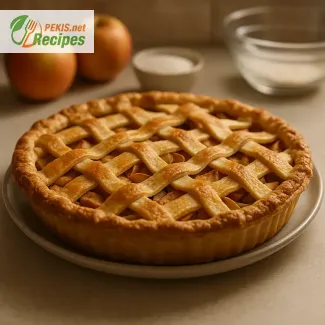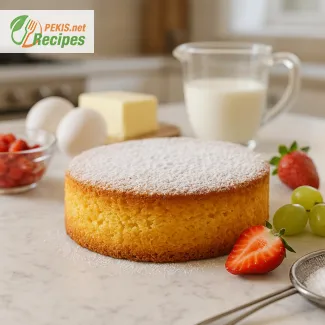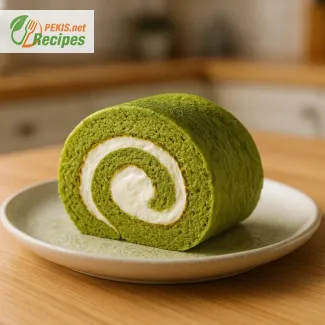
The timeless aroma of homemade apple pie: A comforting classic reimagined
Discover the heartwarming tradition behind every slice of apple pie
Few desserts evoke the same sense of nostalgia, warmth, and comfort as a freshly baked apple pie. With its buttery, flaky crust and tender, spiced apple filling, this iconic dessert has long held a cherished place at family gatherings, holiday feasts, and weekend brunches. Whether served warm with a scoop of vanilla ice cream, alongside a cup of tea, or simply enjoyed on its own, apple pie captures the essence of home baking like no other treat. Its appeal lies not only in its delicate balance of textures and flavors, but also in the emotions it stirs—memories of family traditions, cozy kitchens, and the simple joy of sharing something made with love.
Unlike other desserts that come and go with culinary trends, apple pie remains a perennial favorite, celebrated for its versatility and timeless appeal. From rustic farmhouse-style pies to elegantly latticed versions fit for festive occasions, there’s an apple pie for every table and every taste. This recipe stays true to the roots of the classic while elevating the experience with a perfect blend of sweet and tart apples, warm spices like cinnamon and nutmeg, and a golden, melt-in-your-mouth crust that crumbles just right under the fork.
The essence of simplicity meets perfection
At the heart of a truly great apple pie is the harmony between a few humble ingredients. Crisp, juicy apples are the star, and choosing the right variety—or a mix of them—makes all the difference. Tart Granny Smiths bring structure and zing, while sweeter types like Honeycrisp or Fuji add a natural sweetness and tender bite. Combined with a subtle mix of spices and a touch of lemon juice to brighten the flavors, the filling becomes a luscious, fragrant center that perfectly contrasts with the crisp, buttery shell.
The crust, though often overlooked, is equally essential to the pie’s success. It should be light, flaky, and rich with buttery flavor, providing a sturdy yet tender base that embraces the soft apple interior. Achieving this ideal texture requires attention to detail—cold ingredients, proper resting time, and just the right amount of handling to avoid overworking the dough.
A pie that tells a story in every slice
Apple pie isn't just a dessert—it's a story of heritage and seasonality, woven together through generations of bakers. It has roots in European traditions, particularly English and Dutch cuisine, but has been embraced and transformed in countless kitchens across the globe. In the United States, it’s even come to symbolize comfort, resilience, and national pride, making appearances at Fourth of July picnics, Thanksgiving dinners, and Sunday suppers alike.
What makes this dessert so universally loved is its adaptability. You can create a traditional double-crust pie, a lattice-topped showpiece, or even a crumble-topped version with oats and brown sugar for added texture. Add a splash of bourbon for depth, mix in dried cranberries or raisins for variation, or try a cheddar cheese crust for a savory twist—apple pie invites creativity without losing its comforting soul.
A centerpiece for every occasion
Whether you're preparing a feast for the holidays or simply looking to enjoy a homemade treat on a chilly evening, this apple pie is a showstopping centerpiece that invites admiration even before the first bite. The golden crust, the glossy fruit peeking through the vents, and the enticing scent wafting through your kitchen create an experience that engages all the senses.
This recipe is designed to be approachable for novice bakers and rewarding for experienced ones. Each step, from preparing the dough to seasoning the filling, is crafted with clarity and care, ensuring that the final result will be both delicious and visually stunning. And as the pie emerges from the oven, its bubbling fruit and glistening crust serve as a reminder of the magic that happens when simple ingredients are treated with love and attention.
Celebrating seasonality and tradition
While apple pie can be enjoyed year-round, it’s especially resonant in the autumn months when apple orchards are bursting with fruit, and kitchens are alive with the scent of baking spices. There’s something profoundly satisfying about using fresh, local apples to create a dessert that brings people together, encouraging conversation, laughter, and second helpings.
No matter the season, a well-made apple pie is a celebration of timeless flavors and heartfelt traditions. It invites us to slow down, savor the moment, and share a taste of something familiar and deeply comforting. Whether you bake it for a special event or as an everyday indulgence, this apple pie will quickly become a staple in your recipe repertoire—one that friends and family will ask for again and again.
Ready to bake your own slice of tradition? In the next section, we’ll guide you step by step through the process of creating the perfect homemade apple pie—from selecting apples to achieving that golden crust. Stay tuned for the full recipe and baking tips.
- Prepare the dough: In a large bowl, mix wheat flour, sugar, and salt. Add cold diced butter and use your fingertips or a pastry cutter to blend until the mixture resembles coarse crumbs. Gradually add ice water, one tablespoon at a time, and mix until the dough just comes together. Divide the dough in half, shape into discs, wrap in cling film, and refrigerate for at least 1 hour.
- Prepare the filling: In a large bowl, combine the sliced apples with brown sugar, granulated sugar, cornstarch, cinnamon, nutmeg, salt, lemon juice, and vanilla extract. Toss until all apple slices are evenly coated. Let sit for 15 minutes to allow the flavors to blend and some juices to release.
- Roll out the crust: On a lightly floured surface, roll out one disc of chilled dough into a circle about 30 cm (12 inches) in diameter. Gently transfer it to a 23 cm (9-inch) pie dish. Press it into the base and sides without stretching.
- Add the filling: Pour the apple filling into the prepared pie crust, mounding slightly in the center. Dot with a few small pieces of butter if desired.
- Top the pie: Roll out the second disc of dough and place it over the apples. You can either make a full top crust or create a lattice design. Trim excess dough, fold edges under, and crimp to seal. Cut slits in the top crust if using a full top for steam to escape.
- Chill the pie: Refrigerate the assembled pie for 20 minutes to firm up the crust.
- Bake: Preheat the oven to 200°C (400°F). Brush the top crust with beaten egg and sprinkle with coarse sugar if using. Bake the pie for 20 minutes, then reduce the oven temperature to 175°C (350°F) and bake for an additional 40 minutes or until the crust is golden brown and the filling is bubbling.
- Cool: Let the pie cool on a wire rack for at least 2 hours before slicing. This allows the filling to set properly.
Elevating the classic apple pie: Creative twists and expert tips for a better bake
Transform tradition with flavor, texture, and technique
Apple pie is a beloved dessert that evokes comfort and tradition, but even the most cherished recipes can be enhanced with thoughtful tweaks and culinary creativity. Whether you’re seeking to boost flavor complexity, adjust for dietary needs, or simply elevate your baking skills, there are numerous ways to improve the traditional apple pie. From choosing the right blend of apples to experimenting with spices or crafting a more nutritious crust, small changes can lead to big improvements in taste, texture, and presentation.
Choosing the best apples for a superior filling
The heart of a great apple pie lies in its apple filling, and the choice of apples significantly affects the outcome. Traditional recipes often rely solely on Granny Smith apples due to their tartness and firmness, but mixing in other varieties creates a more complex and rounded flavor profile.
Try combining Granny Smith with Honeycrisp, Braeburn, or Pink Lady apples. The balance between tart and sweet enhances the natural fruitiness of the pie, while using apples with different textures results in a more interesting mouthfeel—some slices retain their bite, while others soften into the filling, creating layers of flavor.
Enhancing the spice blend
Cinnamon is a staple in apple pie, but adding a few complementary spices can give the pie greater depth. A pinch of cardamom introduces a floral warmth, while allspice adds earthy richness. A dash of ground ginger can brighten the filling and balance the sweetness, and freshly grated nutmeg brings a subtle nuttiness and aroma. Be cautious not to overpower the apples—let the spices enhance, not dominate.
For a bold twist, consider infusing the filling with a splash of bourbon or apple brandy. These add a rich, oaky undertone and intensify the apple essence. Just a tablespoon or two can dramatically elevate the pie’s flavor without altering its traditional character.
Upgrading the crust for texture and nutrition
The crust is more than just a vessel—it’s half the pie’s experience. A traditional butter crust is rich and flaky, but with a few changes, it can be flavorful, healthier, and more resilient.
Substitute part of the white flour with whole wheat flour or spelt flour for added fiber and a slightly nutty flavor. For an even healthier version, incorporate ground oats or almond flour, which introduce a delicate texture and nutritional benefits.
If you're avoiding dairy, replace butter with coconut oil or plant-based margarine. These alternatives yield different textures—coconut oil offers crispness, while margarine keeps the crust tender. Just remember to keep all fats cold before mixing for optimal flakiness.
For an extra flavorful crust, mix in a bit of finely grated aged cheddar cheese. It adds a savory edge that contrasts beautifully with the sweet filling, creating a gourmet twist that surprises and delights.
Sweeteners and thickeners: better alternatives
Refined sugar isn’t your only option for sweetening apple pie. Consider using maple syrup, coconut sugar, or date sugar for more nuanced flavors and lower glycemic impact. These natural sweeteners can also enhance the caramel notes in the apples.
Instead of traditional cornstarch, try arrowroot powder or tapioca starch as thickeners. These yield a clearer, glossier filling and can be gentler on the digestive system. They’re especially helpful for those looking for gluten-free options.
Common mistakes and how to avoid them
Even experienced bakers sometimes fall into traps that can compromise their apple pie. One of the most frequent errors is under-seasoning the filling. Apples need more than just sugar—salt, lemon juice, and spices are essential for bringing out their best qualities.
Another issue is soggy crusts. Prevent this by brushing the bottom crust with a thin layer of egg white or apricot jam before adding the filling. This barrier helps to seal the crust and maintain its crispness.
Overstuffing the pie is also a concern. While it might seem generous, too much filling can lead to uneven baking and messy slicing. Stick to the recommended amount and arrange the slices evenly to allow for proper steam release.
Finally, baking at too low a temperature can result in a pale, underbaked crust. Start at a higher heat (200°C / 400°F) for the first 20 minutes to set the crust, then lower the temperature to finish baking slowly and evenly.
Why homemade always wins
Store-bought pies may offer convenience, but nothing compares to homemade. Crafting an apple pie from scratch allows for full control over ingredients, quality, and freshness. You can select organic apples, tailor the sweetness to your preference, and eliminate preservatives entirely. It also invites personalization—whether through decorative lattices, signature spice blends, or unique crust designs.
The emotional value of a homemade pie is just as significant. The aroma of apples and spices wafting through your home, the pride of creating something from start to finish, and the joy of sharing a handmade dessert make the experience far more rewarding than anything off a shelf.
Making it healthier without losing tradition
For those watching their intake, apple pie can still be enjoyed with a few health-conscious adjustments. Reduce the sugar slightly or replace it with natural fruit purees like apple or pear. Use unrefined flours or gluten-free blends to support specific dietary needs. Bake the pie open-faced (like a galette) to lower the fat content from the crust, or use a streusel topping made from oats and nuts for extra crunch and nutrition.
You can also incorporate chia seeds or ground flaxseeds into the filling. These not only act as thickeners but also add omega-3 fatty acids and fiber, promoting satiety and heart health.
Apple pie doesn’t have to be reinvented—it just needs to be reimagined thoughtfully. With small changes in technique and ingredient selection, the traditional apple pie transforms into a more refined, flavorful, and personalized dessert. Whether you're aiming for a healthier option, a bolder flavor, or a more elegant presentation, these strategies empower you to bake a pie that reflects your taste and creativity, while still honoring the timeless tradition that makes apple pie a beloved favorite around the world.
- Gluten (wheat flour)
- Dairy (butter)
- Egg
Substitution tips for allergens and gluten:
- Use gluten-free all-purpose flour mix with xanthan gum (same quantity) to eliminate gluten.
- Replace butter with vegan butter or refined coconut oil for a dairy-free option.
- Omit the egg wash or use plant-based milk with maple syrup for brushing to avoid eggs
- Vitamin C: 5 mg – supports immune health and collagen production
- Vitamin A: 120 IU – essential for vision and skin health
- Potassium: 190 mg – helps regulate blood pressure and nerve function
- Calcium: 20 mg – supports bone and dental health
- Iron: 1.1 mg – contributes to red blood cell formation
- Polyphenols from apples: approx. 200 mg – support heart health and reduce inflammation
- Cinnamaldehyde from cinnamon: approx. 15 mg – aids in blood sugar control and provides anti-inflammatory benefits
This classic apple pie recipe offers a perfect balance of flavor and texture, ideal for any occasion. Its traditional roots combined with thoughtful preparation result in a dessert that's both satisfying and memorable. With optional adjustments, it can be made suitable for gluten-free and dairy-free diets, making it a versatile choice for modern kitchens.





